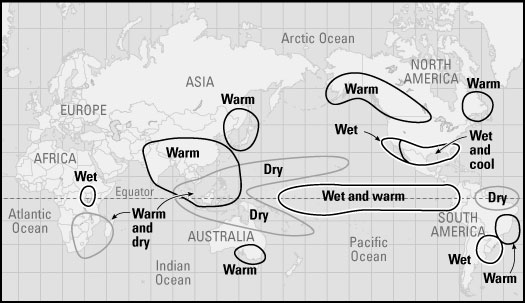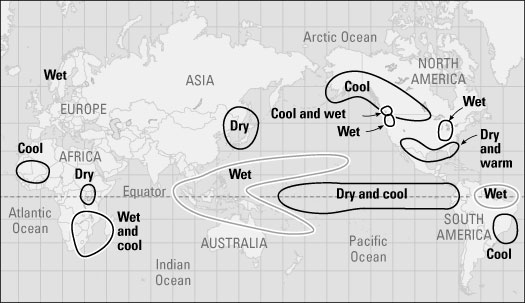Figure 1: Features of El Niño across the tropical Pacific.
These important season-changing conditions — the Warm Pool and the big thunderstorms and the winds — seem to swing back and forth from one extreme to another across the tropical Pacific Ocean. On average, every three to seven years El Niño seems to come along. But "average" and "normal" are not very good words to use with things like El Niño. Like a lot of things about weather, "average" and "normal" don't seem to come around very often. The swings from especially warm to especially cool Pacific Ocean conditions are not regular, and their pattern is not reliable.
Some climate experts at the Go Figure Academy of Sciences and elsewhere have been trying to make a computer model that acts like the Pacific Ocean, swinging between warm and cool, so that they can predict when El Niño will show his face. But they're not very good at it yet. On the other hand, scientists have become very good at using new tools like satellites and buoys moored across the ocean to detect changes in the temperature of the water and in the winds. So once El Niño conditions begin to take shape, they can see them sooner. If you live in a region that feels El Niño's effects, this means that some years climate experts may be able to warn you months in advance about what kind of winter to expect. Figure 2 shows the patterns of global weather that are linked to a powerful El Niño.
>

Figure 2: Common winter weather impacts of El Niño.
La Niña, the contrary sister
El Niño causes some serious weather problems around the world, no doubt about it, but La Niña, which Figure 3 illustrates, is not exactly a sweet little thing either. In places like the northeastern United States that are accustomed to cold and snowy winters, La Niña often makes for especially hard winters. In the rainy Pacific Northwest, La Niña winters seem to bring even more rain and snow than usual.
>

Figure 3: Features of La Niña across the tropical Pacific.
Across the desert Southwest, often the season is even drier than normal. Tornadoes seem especially numerous during springs and summers of La Niña, and the Atlantic hurricane season can be especially long and dangerous. In 1999, for example, while La Niña conditions prevailed in the tropical Pacific Ocean, 12 tropical storms grew big enough to earn names, eight of them became hurricanes, and five became intense hurricanes.
Here is a rule that is not always exactly true, but still is useful to compare the impacts of El Niño and his contrary sister. Where El Niño is warm, La Niña is cool. Where El Niño is wet, La Niña is dry. While El Niño conditions and their seasonal impacts look very different from normal, La Niña conditions often bring winters that are typical — only more so. There's something else to keep in mind: El Niño and La Niña tend to make seasonal conditions one way or another, but every El Niño and La Niña is different.
The La Niña look
Like a lot of brothers and sisters, El Niño and La Niña don't get along together. In the tropical Pacific Ocean, they are opposites. If you have one, you can't have the other. In the ocean, the uppermost layer of warm water — which flattens out during El Niño — now has an especially sharp wedge-shape to itself during La Niña. It is thick up against South Asia, where the Warm Pool is especially deep. Above the ocean, the tradewinds are especially strong. And on the opposite side of the ocean, up against South America, because of the strong offshore winds, the warm surface layer disappears altogether. The deeper cold water is flowing directly up to the surface for a great distance along the Equator. This means that the Cold Tongue is sticking out far into the sea.
La Niña impacts on the world's weather are less predictable than the effects wrought by El Niño. This is mainly because of the big differences in the jet stream and the storm track. El Niño causes the Pacific storm track to become stronger, to drop farther south than usual, and to straighten out like a necklace of weather extending more-or-less straight across the ocean. The La Niña storm track is weaker and loopy and irregular, like a piece of wet and wiggly spaghetti, more changeable — so the behavior and direction of the storms it carries are more difficult to accurately forecast (see Figure 4).
>

Figure 4: Common winter weather impacts of La Niña.
>
dummies
Source:http://www.dummies.com/how-to/content/el-nino-and-la-nina-weathers-sibling-rivalry.html
No comments:
Post a Comment